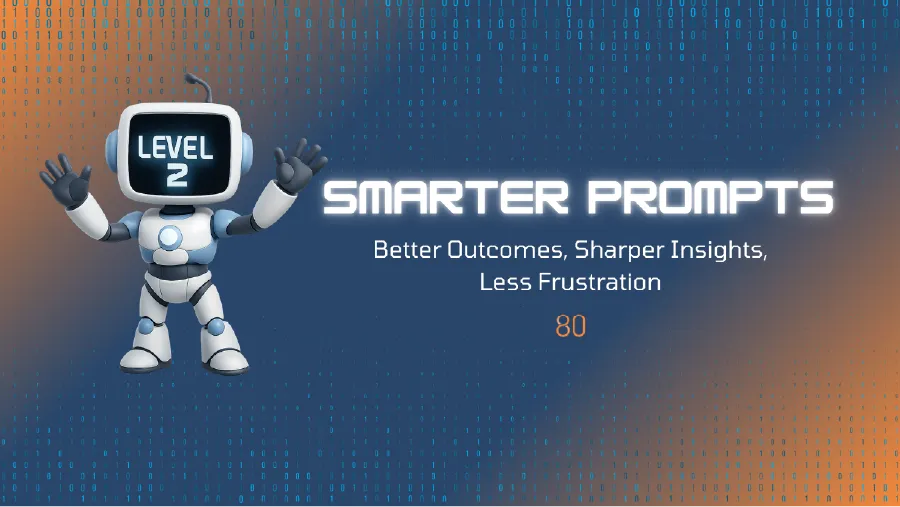In Part 1, we covered how simple one-line prompts can help you get started. But when you want sharper, more tailored outputs, it's time to level up. This stage is all about giving the AI just enough structure and direction to behave more like a trained freelancer than a guessing game.
We call this Level 2: Smarter Prompting. It’s where you introduce context, goals, and roles—helping AI deliver clearer, more actionable responses.
Here are six smart prompting techniques that can dramatically improve your results:
1. Ask AI to Ask You Questions
What It Is: Use this technique when you're not sure how to begin, or when your request is too broad.
Why It Works: AI becomes an active collaborator by helping clarify what it needs from you to perform well.
Use Case: Drafting a new email campaign but unsure what to include.
Example Prompts:
Prompt: "I want to write an email for new donors. Ask me what you need to know first."
Prompt: "You’re a prompt coach. Ask me 3 questions to help build a better prompt."
2. Shift the Perspective
What It Is: Assign AI a specific persona or role to shape its output in a unique tone, format, or style.
Why It Works: You get responses written from a specific angle—making content more targeted and aligned.
Use Case: Repurposing internal updates for public audiences.
Example Prompts:
- Instead of: "Summarize this update."
Try:
Prompt: "You're a community journalist. Rewrite this update to sound like a story for our local paper."
3. Simplify Your Ask
What It Is: Break big prompts into smaller, more manageable tasks.
Why It Works: Reduces confusion and helps AI stay focused. Small steps often build into better results.
Use Case: You need a full campaign, but don’t want to overwhelm the model or yourself.
Example Prompts:
- Instead of: "Write a full marketing plan that includes emails, graphics, and social copy."
Try:
Prompt: "Draft a one-paragraph email for our fall fundraiser. We'll build the rest from there."
4. Impose Creative Constraints
What It Is: Add rules for length, format, structure, or word choice.
Why It Works: Constraints encourage clarity and creativity by giving boundaries for the AI to work within.
Use Case: Naming events, writing subject lines, or crafting social captions.
Try:
Prompt: "Give me three name ideas under five words for our mentoring program. Must include a metaphor."
5. Use Templates or Frameworks
What It Is: Build your prompt around proven communication models such as PAS (Problem, Agitation, Solution) or AIDA (Attention, Interest, Desire, Action).
Why It Works: Frameworks guide structure and pacing, leading to more impactful, audience-aware messaging.
Use Case: Writing appeals, landing pages, or campaign emails.
Try:
Prompt: "Write a donor email using the PAS framework. Tone: grateful and encouraging. Audience: first-time givers."
6. Modify the Language
What It Is: Refine the way you phrase your prompt to shape the tone or format.
Why It Works: AI responds to how you ask, not just what you ask. Better phrasing = better alignment.
Use Case: Drafting scripts, speeches, or leadership messages.
Example Prompts:
- Instead of: "Make this better."
- Try:
Prompt: "Rewrite this like a speech from our executive director—authentic, inspirational, and clear."
Sample Use Cases Across These Techniques
- "You're a communications director. Write a donor renewal email with a warm tone, encouraging a past donor to give again this year."
- "Act as a grant writer. Create a summary paragraph for a foundation application focused on youth literacy."
- "You're an event coordinator planning a 3-hour community clean-up. Make a checklist for volunteers."
Why It Works
Smart prompts give AI more than just a task—they offer guidance, structure, and intent. This helps AI make better decisions, use the right tone, and create content that’s aligned with your brand, team, or audience. You’re not just telling it what to do. You’re shaping how it thinks.
Final Thoughts
Smarter prompts are where most people start seeing serious improvements in their AI experience. With just a little structure and context, you can transform generic outputs into customized, high-quality work.
In the final post of this series, we’ll explore advanced prompting techniques, including prompt chaining, self-critiquing, meta prompts, and role-play simulations. These tools will help you unlock AI’s full potential as a true thought partner—not just a task taker.
Ready to go deeper? Stay tuned for Part 3: Advanced Prompting.
